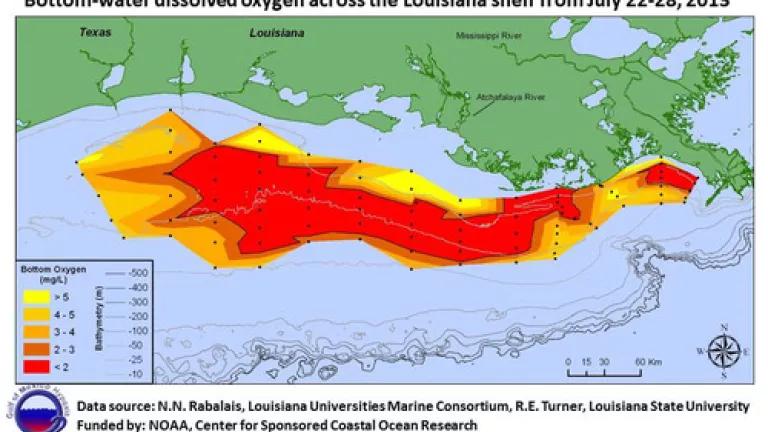
What would you think if I told you that your tax dollars were helping to create an enormous annual area in the Gulf of Mexico where the sea floor water was so oxygen-deprived that it couldn't sustain life? Unfortunately, that's exactly what is happening today. The good news, though, is that there are solutions to this self-destructive cycle, as my colleague Claire O'Connor discusses in an important new NRDC policy paper called "Soil Matters," released today.
A quick primer on the Dead Zone: nitrogen and phosphorus pollution comes from a variety of sources, including runoff from row crops, waste generated by industrial livestock operations, sewage treatment plants, and urban and suburban stormwater. Pollution flows down the Mississippi River, nourishing algae blooms in the Gulf, and when those algae die off, the resulting processes cause an area of the Gulf's bottom layer of water to become so oxygen-deprived (or "hypoxic") that fish and many other aquatic organisms either flee or die. In recent decades, the average size of the "Dead Zone" has reached state-sized proportions; this year, it was about the size of Connecticut.
One of the contributing factors to this pollution is that crops in the Mississippi basin (which are most commonly corn or soybeans) are frequently grown without using practices that can help limit nitrogen and phosphorus runoff. For example, the use of cover crops reduces nitrogen and phosphorus runoff and can reduce the need for applied nitrogen. No-till practices are also smart from a pollution-reduction standpoint; research comparing pollutant runoff in no-till farming with that from chisel till farming indicates that “no-till had only slightly higher dissolved P losses compared to chisel, but had lower soil, nitrate-N, and total P losses.” The video below demonstrates how practices like no-till and cover cropping build healthy soil that resists runoff and can reduce the nutrients pouring down the Mississippi to the Gulf.
These soil-building practices also have a range of additional benefits, and can significantly reduce a farmer’s risk of crop loss. As Claire’s paper discusses, “in 2010, corn farmers who used no-till were 30 percent less likely than their conventional-tilling peers to receive an indemnity payment” from the Federal Crop Insurance Program and, “[i]f all corn farmers who used methods other than no-till had instead used the no-till technique, approximately $224 million in indemnities could potentially have been avoided in 2010.”
Unfortunately, current crop insurance policies do not incentivize the use of these risk-reducing strategies. Instead, because crop insurance rates are set using a formula that doesn't take into account what farmers do on their individual fields, the program encourages high-risk practices, such as cultivating marginal lands. In turn, farmers often need to increase chemical inputs to maintain those less productive acres, creating a cycle of brittle, loss-prone farms and increased environmental problems. It's almost like a car insurance company charging less to insure a driver with reckless driving citations than a driver with an impeccable record.
Ultimately, these unwise financial incentives will need to be broadly reformed. But in the meantime, there is a mechanism in current law that could help – crop insurance companies may propose a “pilot program” to the Risk Management Agency within the Department of Agriculture, under which the RMA could alter its typical approach and instead offer reduced insurance premiums for certain kinds of producers. NRDC’s new paper makes the case that the RMA should establish such a pilot for farmers employing soil-building, risk-reducing practices.
If we can get this going, insurers will be able to offer the crop insurance equivalent of a “safe driver” discount for which you might be eligible on your auto policy. Whether they’ll call it a “smart farmer” discount or not, that’s what it would be.

